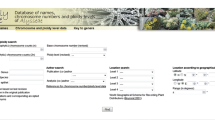Abstract
Chromosome numbers are reported for 155 collections ofCastilleja representing 54 taxa. The basic haploid number of 12 was found in 34 taxa, but 10 of these also had one or more polyploid levels. The remaining 20 species were strictly polyploid in one or more levels (4X, 6X, 8X, 10X, 12X). The widespread occurrence of polyploidy, along with hybridization, is believed to be largely responsible for the complex morphological variation found within the genus. Specific examples of the role of polyploidy and hybridization in creating this variation are discussed for the following species complexes:C. affinis, C. applegatei, C. miniata, C. peckiana.
Similar content being viewed by others
Literature Cited
Bacigalupi, R. 1966. A new combination in a CaliforniaCastilleja. Leafl. Western Bot.10: 286, 287.
Beaman, J. H., D. C. D. Dejong, &W. P. Stoutamire. 1962. Chromosome studies in the alpine and subalpine floras of Mexico and Guatemala. Amer. Jour. Bot.49: 41–50.
Bentham, G. 1846.Castilleja. In: DeCandolle, A., Prodromus Systematis Naturalis Regni Vegetabilis. Pars 10. pp. 528–534.
Eastwood, Alice. 1909. Synopsis of the Mexican and Central American species ofCastilleja. Proc. Amer. Acad. Arts Sci.44: 563–591.
Gillett, G. W. 1954.In: Documented chromosome numbers of plants. Madroño12: 210.
Heckard, L. R. 1958.In: Documented chromosome numbers of plants. Madroño14: 237.
—. 1962. Root parasitism inCastilleja. Bot. Gaz.124: 21–29.
—. 1964. Causes of taxonomic complexity inCastilleja. Amer. Jour. Bot.51: 686. (Abstract)
Löve, A. &Doris Löve. 1961. Chromosome numbers of central and northwest European plant species. Opera Botanica5: 1–581.
—. 1964.In: IOPB chromosome number reports II. Taxon13: 207.
Munz, P. A. 1959. A California Flora. Berkeley & Los Angeles: Univ. California Press. 1681 pp.
Ownbey, M. 1959.Castilleja. In: Hitchcock, C. L., A. Cronquist, M. Ownbey, & J. Thompson. Vascular Plants of the Pacific Northwest. Univ. Washington Publ. Biol. 17(4) : 295–326.
Pennell, F. W. 1941. New Scrophulariaceae from Oregon. II.Castilleja. Notulae Naturae (Philadelphia)74: 1–11.
—. 1951.Castilleja. In: Abrams, L. Illustrated Flora of the Pacific States, Washington, Oregon, and California. Stanford, California: Stanford Univ. Press. 3: 819–846.
Sokolovskaya, A. P. &O. S. Strelkova. 1941. Polyploidy and karyological races under conditions in the arctic. Compt. Rend. Acad. URSS [Dokl. Akad. Nauk SSSR]32: 144–147.
—. 1960. [Geographic distribution of the polyploid species of plants in the Eurasiatic Arctic] Bot. Zhur. SSSR45: 369–381. (In Russian)
Stebbins, G. L., Jr. 1950. Variation and Evolution in Plants. New York: Columbia Univ. Press, xx + 643 pp.
Taylor, R. L. 1967.In: IOPB chromosome number reports XIII. Taxon16: 459.
Author information
Authors and Affiliations
Rights and permissions
About this article
Cite this article
Heckard, L.R. Chromosome numbers and polyploidy in Castilleja (Scrophulariaceae). Brittonia 20, 212–226 (1968). https://doi.org/10.2307/2805444
Issue Date:
DOI: https://doi.org/10.2307/2805444




